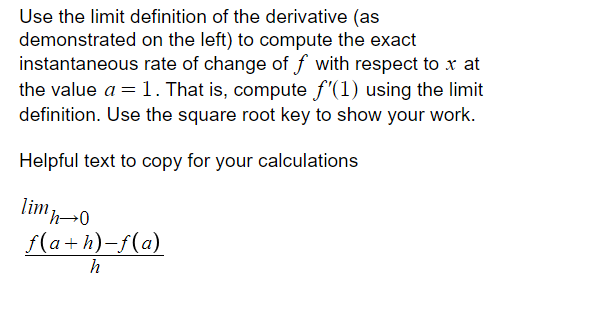Use the limit definition of the derivative (as demonstrated on the left) to compute the exact instantaneous rate of change of ƒ with respect to x at the value a =1. That is, compute f'(1) using the limit definition. Use the square root key to show your work. Helpful text to copy for your calculations limn-0 f(a+h)-f(a)
Use the limit definition of the derivative (as demonstrated on the left) to compute the exact instantaneous rate of change of ƒ with respect to x at the value a =1. That is, compute f'(1) using the limit definition. Use the square root key to show your work. Helpful text to copy for your calculations limn-0 f(a+h)-f(a)
College Algebra (MindTap Course List)
12th Edition
ISBN:9781305652231
Author:R. David Gustafson, Jeff Hughes
Publisher:R. David Gustafson, Jeff Hughes
Chapter4: Polynomial And Rational Functions
Section4.2: Polynomial Functions
Problem 96E: What is the purpose of the Intermediate Value Theorem?
Related questions
Concept explainers
Rate of Change
The relation between two quantities which displays how much greater one quantity is than another is called ratio.
Slope
The change in the vertical distances is known as the rise and the change in the horizontal distances is known as the run. So, the rise divided by run is nothing but a slope value. It is calculated with simple algebraic equations as:
Question

Transcribed Image Text:Use the limit definition of the derivative (as
demonstrated on the left) to compute the exact
instantaneous rate of change of f with respect to x at
the value a = 1. That is, compute f'(1) using the limit
definition. Use the square root key to show your work.
Helpful text to copy for your calculations
limn0
f(a+h)-f(a)
Expert Solution
This question has been solved!
Explore an expertly crafted, step-by-step solution for a thorough understanding of key concepts.
Step by step
Solved in 2 steps

Knowledge Booster
Learn more about
Need a deep-dive on the concept behind this application? Look no further. Learn more about this topic, calculus and related others by exploring similar questions and additional content below.Recommended textbooks for you

College Algebra (MindTap Course List)
Algebra
ISBN:
9781305652231
Author:
R. David Gustafson, Jeff Hughes
Publisher:
Cengage Learning

College Algebra (MindTap Course List)
Algebra
ISBN:
9781305652231
Author:
R. David Gustafson, Jeff Hughes
Publisher:
Cengage Learning